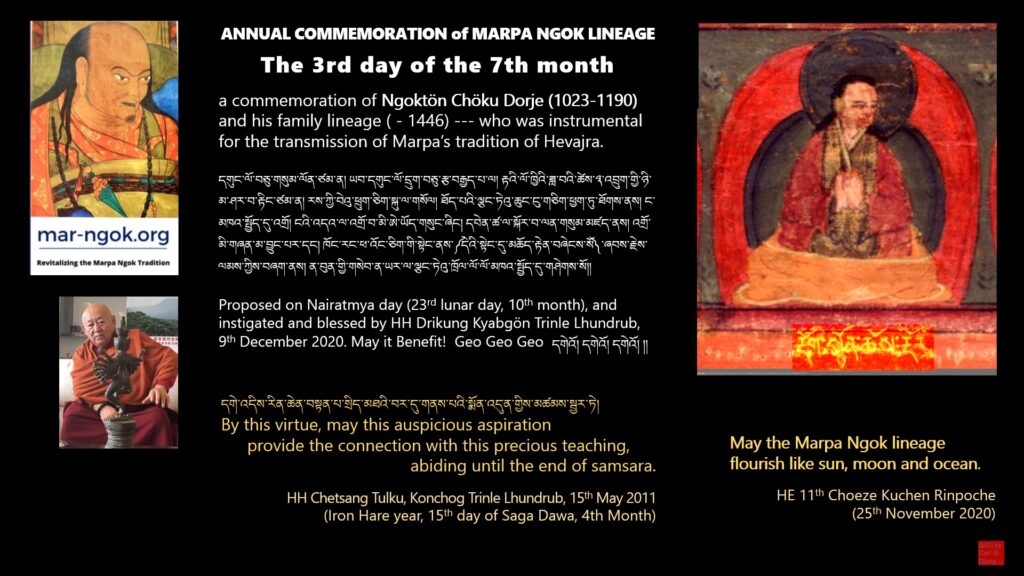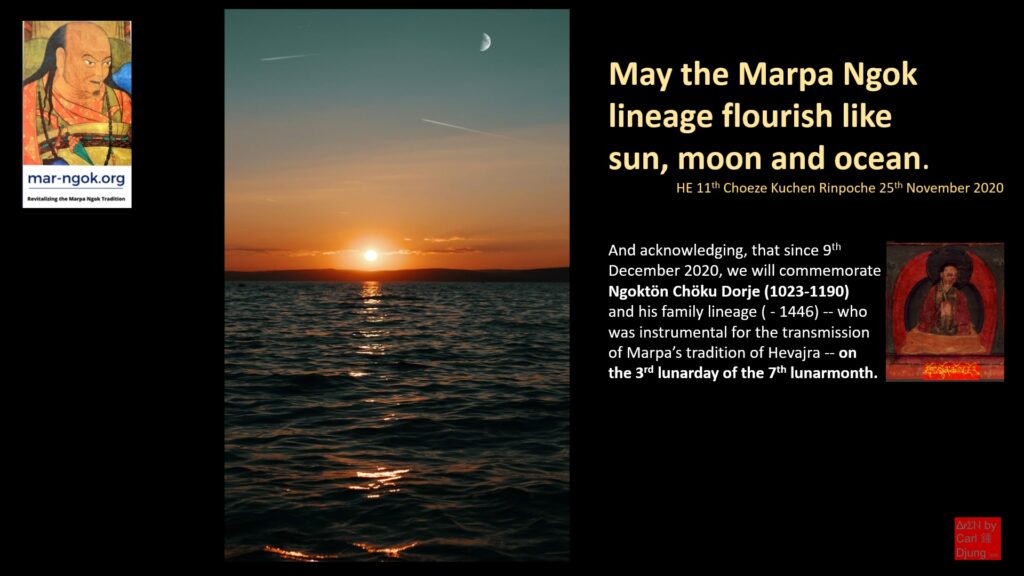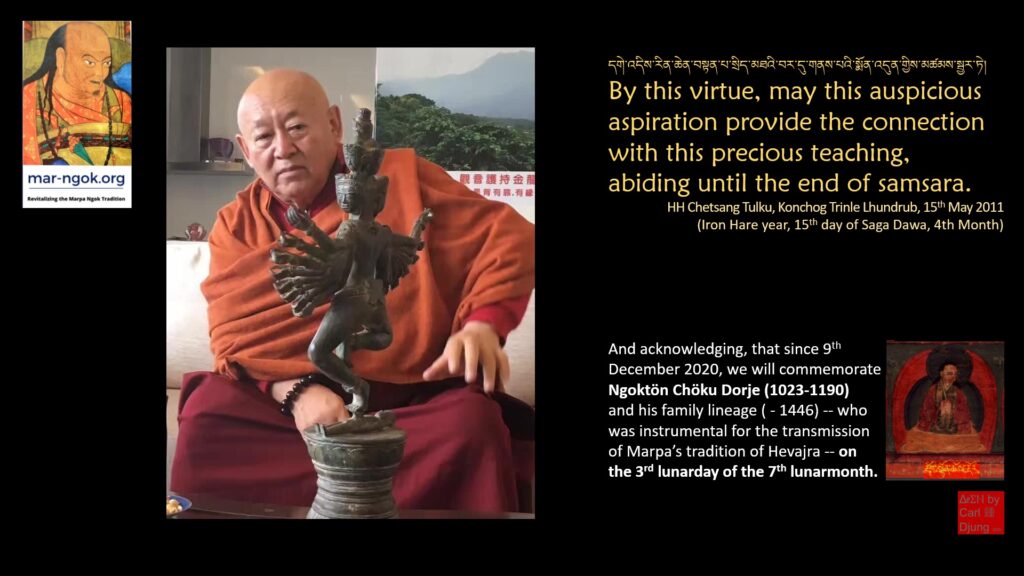COMMEMORATION DAYS for the PRACTISES and the Mar-Ngok LINEAGE
If one is connected to the Hevajra practises and/or the Nairatmya practises, and one wishes to REMIND and COMMEMORATE … there are TWO good MONTHLY days and ONE good ANNUAL day were one can tune in to the blessing of the Marpa Ngok Hevajra Nairatmya transmission: „The Blessing enables the offsprings to follow in the footsteps of the father!“. The two monthly days has focus on the practise. The annual day has focus on the lineage.

The 15th lunar day of the 1st lunar month. Commemoration of the Parinirvana of Naropa (1016-1100)
****
The 15th lunar day of the 1st lunar month. Commemoration of the Parinirvana of Marpa Lotsava (either 1000-1086 or 1012-1097)
****
The 3rd lunarday of the 7th lunarmonth is the parinirvana of Ngoktön Chöku Dorje (1023-1190), pupil of Marpa the Translator. This is henceforth the special commemoration day for the Marpa Ngok Tradition. It is a commemoration of Ngoktön Chö
དགུང་ལོ་བཅུ་གསུམ་ལོན་ཙམ་ན། ཡབ་དགུང་ལོ་དྲུག་བཅུ་རྩ་བརྒྱད་
Proposed on Nairatmya day (23rd lunar day, 10th month), and instigated and blessed by HH Drikung Kyabgön Trinle Lhundru
The more precise words/arguments (by Cecile Ducher, 8th december 2020):
An examination of the date of Ngok Chödor (1023-1090)
According to a Ngok Family history written in 1360,the Rosary of Precious Ornaments—Lives of the Successive Ngokpa Masters, Fathers and Sons [ བླ་མ་ རྔོག་པ་ ཡབ་སྲས་ རིམ་བྱོན་ པའི་རྣམ་ རྣམ་ཐར་ རིན་པོ་ཆེའི་རྒྱན་ གྱི་ ཕྲེང་བ་](Bla ma rngog pa yab sras rim byon pa’i rnam thar rin po che’i rgyan gyi phreng ba), when Ngok Dodé was twelve and his father sixty-seven, after sunrise on the dragon third day of the dog month of a horse year, while wearing a thin cotton fabric over his body and carrying a small skull hand-drum, Chödor said: “I’m going to Kachö; is there someone going with me?” He did three circumambulations around the retreat place, and as no one else came, he stepped on a boulder, left a dazzling footprint, and ascended in the mist towards Kachö in the sound of the hand-drum.
དགུང་ལོ་བཅུ་གསུམ་ལོན་ཙམ་ན། ཡབ་དགུང་ལོ་དྲུག་བཅུ་རྩ་བརྒྱད་
Although the Rosary of Precious Ornaments does not indicate the element of the horse year when Ngok Chödor left for Kachö, two later sources, the Lhorong Chöjung and the Debter Ngönpo, propose either 1090 (iron male horse) or 1102 (water male horse). These two sources similarly propose alternative datings for Marpa and all Ngok masters, the Lhorong Chöjunggenerally indicating a 12-year cycle earlier than the Debter Ngönpo. Although no decisive outer indication helps to decide between the two, the general chronology of the Ngok masters proposed in the Lhorong Chöjung is better on several account, hence the proposed dates for Ngok Chödor are 1023-1090 (instead of 1036-1102 for the Debter Ngönpo). Both the Lhorong Chöjung and the Rosary of Precious Ornamentsindicate that Ngok Chödor died on the third day of the dog month, while the Debter Ngönpo gives no detail. The dog month according to the Kalacakra system is the seventh month.
As the Hevajra Sadhana Offering in Phyang Monastery is held from the 4thto the 15thof the seventh month each year, we suggest that on the day previous to the Hevajra group retreat, on the 3rd day of the 7thmonth, there may be a commemoration of Ngok Chödor and his family lineage, who was instrumental for the transmission of Marpa’s tradition of Hevajra.
By this virtue, may this auspicious aspiration
provide the connection with this precious teaching,
abiding until the end of samsara.
HH Chetsang Tulku, Konchog Trinle Lhundrub
May the Marpa Ngok lineage flourish like sun, moon and ocean.
HE 11th Choeze Kuchen Rinpoche (25th November 2020)


